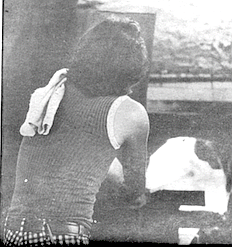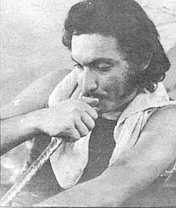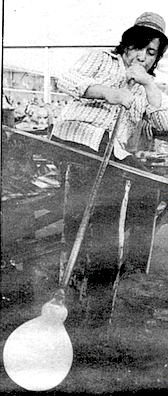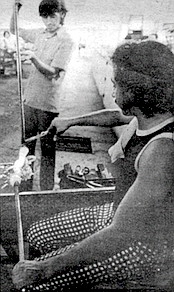 Facebook
Facebook
 X
X
 Instagram
Instagram
 TikTok
TikTok
 Youtube
Youtube

You might never even notice it, unless you were looking for it. The rows of little clowns and transparent containers might mis-lead you into thinking this is another Tijuana tourist store. But walk all the way to the back... There you can hear the roar of a huge, open gas kiln. There you can see half-naked men bent over their work, their faces glowing from the heat from the 2500-degree oven. This is the Inco Glass Factory, right across the street from the Jai Alai Palace.
The raging inferno inside the kiln absorbs your attention first. All the activity swarms around it, like bees around a hive. The bee-workers approach the oven at regular intervals, in a well-defined pattern. Their flushed faces reflect the intense heat.

Seated along the wall on an elevated platform, you can overlook the work area: a dirt arena with the main brick kiln as centerpiece. Like red magma, the molten glass and the different metallic oxides necessary to color it radiate in the vats inside the kiln. Three other kilns, used only for the cooling process, line the opposite wall, and several whirling fans stir up the warm air. Three men, sitting astride worn work-benches, work on the glass artifacts; the strenuous conditions contrast sharply with the informal attitude among the workers.

Beads of sweat stream down Rafael Garcia’s face as I talk to him. A hefty and very affable young man, Rafael migrated here from Mexico City. Nothing in his background had prepared him for glass blowing: the creativity of the art appealed to him after a visit to a factory one day. So he became an apprentice for about three years. He cleaned up after his teacher, sorted broken glass and little by little was allowed to relegate these menial tasks to others while he worked his way up. He is now a maestro in his own right and makes 8 to 10 pieces a day.

It is obvious he enjoys his work, as you watch him twirl his cana – a long, metal pipe through which he blows jugs and containers into shape; he sometimes lets the molten material stretch a little or uses antiquated shears to cut off an unnecessary piece. Interspersed with our conversation, a few quick glances and sharp wrist motions transform the molten glass into a swan. The red hot material hardens almost instantly. His apprentice grabs the cana and quickly puts everything in the kiln for a few moments, and the intense heat soon brings it back up to the required temperature. While he waits, Rafael catches his breath, mops his brow and smiles: “This is a good paying job, and there are very few of us”. He takes the cana back, wets it down so he can hold on to it, and allows his apprentice to stick the beak and the wings delicately onto the body of the swan.

Another maestro, Rogelio Corona, a wiry little man older than Rafael, has been a glass-blower for fifteen years. Moved up to Tijuana by the company, Rogelio specializes in the smaller pieces and produces up to 22 of them a day. He designs and perfects his own creations and they are reproduced by the dozen at the factory. A master like him can earn up to $150 a week.
The hot and clammy air doesn’t bother Carlos Mora a bit as he swings his cana back and forth to shape the molten glass into a punchbowl. He takes a short break while his apprentice places it in the cooling oven. My preconception that the art of glass blowing is still handed down from father to son begins to disintegrate, as I find out that family tradition did not shape Carlos’ decision either. The manual dexterity of Guadalajara artists at work fascinated him and he applied for an apprenticeship. The maestro now refines his own original pieces. The apprentice hands him a new blob of molten glass at the end of his cana; he rolls it up and down on a slanted plank, holds it up like a trumpet and effortlessly puffs the molten material to size. The body of an elephant takes shape. The apprentice gently adds the tusks as Carlos puts on the finishing touches. It is now ready for the first part of the forty-eight hour cooling process. Each of the three cooling kilns gradually drops in temperature and is sealed off at night to prevent any drastic change in the atmosphere. The following morning, the elephant is moved to the next kiln; after it is thoroughly hardened, it is taken to the polishers’ table where the rough edges are filed down.
At this end of the factory, row upon row of clowns, vases, bulls, and other artifacts line the counters, awaiting nationwide distribution. You will never find two perfectly matched pieces, since each maestro’s whim is enough to give each piece its own personality.
Hardly a lull breaks up the activity. From the maestros to the apprentices, the wares take shape in well-synchronized motions. The art has remained unchanged through the ages and can be traced as far back as the Phoenicians. The first Mexican factory was established in Puebla in the sixteenth century, when Italian artisans from Venice introduced the art to the Indians. The Indians, in turn, set up shops in Monterrey and Guadalajara. The knowledge was first handed down from father to son, but today anyone willing to go through the strenuous three years of apprenticeship can become a glass-blower.
The Tijuana factory stands alone at this end of the border. The manager, Mr. Torres, decided to open it in 1966 because of its proximity to the U.S. He deals almost exclusively in wholesale orders. “I am a businessman,” he told me, “and this is good business.” And anyone observing this fascinating enterprise has to believe him. This touch of old Venice in the heart of modem Tijuana might seem a little incongruous; but not even the “feed the kitty if you enjoyed it” sign can detract from this demonstration of living history.


You might never even notice it, unless you were looking for it. The rows of little clowns and transparent containers might mis-lead you into thinking this is another Tijuana tourist store. But walk all the way to the back... There you can hear the roar of a huge, open gas kiln. There you can see half-naked men bent over their work, their faces glowing from the heat from the 2500-degree oven. This is the Inco Glass Factory, right across the street from the Jai Alai Palace.
The raging inferno inside the kiln absorbs your attention first. All the activity swarms around it, like bees around a hive. The bee-workers approach the oven at regular intervals, in a well-defined pattern. Their flushed faces reflect the intense heat.

Seated along the wall on an elevated platform, you can overlook the work area: a dirt arena with the main brick kiln as centerpiece. Like red magma, the molten glass and the different metallic oxides necessary to color it radiate in the vats inside the kiln. Three other kilns, used only for the cooling process, line the opposite wall, and several whirling fans stir up the warm air. Three men, sitting astride worn work-benches, work on the glass artifacts; the strenuous conditions contrast sharply with the informal attitude among the workers.

Beads of sweat stream down Rafael Garcia’s face as I talk to him. A hefty and very affable young man, Rafael migrated here from Mexico City. Nothing in his background had prepared him for glass blowing: the creativity of the art appealed to him after a visit to a factory one day. So he became an apprentice for about three years. He cleaned up after his teacher, sorted broken glass and little by little was allowed to relegate these menial tasks to others while he worked his way up. He is now a maestro in his own right and makes 8 to 10 pieces a day.

It is obvious he enjoys his work, as you watch him twirl his cana – a long, metal pipe through which he blows jugs and containers into shape; he sometimes lets the molten material stretch a little or uses antiquated shears to cut off an unnecessary piece. Interspersed with our conversation, a few quick glances and sharp wrist motions transform the molten glass into a swan. The red hot material hardens almost instantly. His apprentice grabs the cana and quickly puts everything in the kiln for a few moments, and the intense heat soon brings it back up to the required temperature. While he waits, Rafael catches his breath, mops his brow and smiles: “This is a good paying job, and there are very few of us”. He takes the cana back, wets it down so he can hold on to it, and allows his apprentice to stick the beak and the wings delicately onto the body of the swan.

Another maestro, Rogelio Corona, a wiry little man older than Rafael, has been a glass-blower for fifteen years. Moved up to Tijuana by the company, Rogelio specializes in the smaller pieces and produces up to 22 of them a day. He designs and perfects his own creations and they are reproduced by the dozen at the factory. A master like him can earn up to $150 a week.
The hot and clammy air doesn’t bother Carlos Mora a bit as he swings his cana back and forth to shape the molten glass into a punchbowl. He takes a short break while his apprentice places it in the cooling oven. My preconception that the art of glass blowing is still handed down from father to son begins to disintegrate, as I find out that family tradition did not shape Carlos’ decision either. The manual dexterity of Guadalajara artists at work fascinated him and he applied for an apprenticeship. The maestro now refines his own original pieces. The apprentice hands him a new blob of molten glass at the end of his cana; he rolls it up and down on a slanted plank, holds it up like a trumpet and effortlessly puffs the molten material to size. The body of an elephant takes shape. The apprentice gently adds the tusks as Carlos puts on the finishing touches. It is now ready for the first part of the forty-eight hour cooling process. Each of the three cooling kilns gradually drops in temperature and is sealed off at night to prevent any drastic change in the atmosphere. The following morning, the elephant is moved to the next kiln; after it is thoroughly hardened, it is taken to the polishers’ table where the rough edges are filed down.
At this end of the factory, row upon row of clowns, vases, bulls, and other artifacts line the counters, awaiting nationwide distribution. You will never find two perfectly matched pieces, since each maestro’s whim is enough to give each piece its own personality.
Hardly a lull breaks up the activity. From the maestros to the apprentices, the wares take shape in well-synchronized motions. The art has remained unchanged through the ages and can be traced as far back as the Phoenicians. The first Mexican factory was established in Puebla in the sixteenth century, when Italian artisans from Venice introduced the art to the Indians. The Indians, in turn, set up shops in Monterrey and Guadalajara. The knowledge was first handed down from father to son, but today anyone willing to go through the strenuous three years of apprenticeship can become a glass-blower.
The Tijuana factory stands alone at this end of the border. The manager, Mr. Torres, decided to open it in 1966 because of its proximity to the U.S. He deals almost exclusively in wholesale orders. “I am a businessman,” he told me, “and this is good business.” And anyone observing this fascinating enterprise has to believe him. This touch of old Venice in the heart of modem Tijuana might seem a little incongruous; but not even the “feed the kitty if you enjoyed it” sign can detract from this demonstration of living history.
Comments